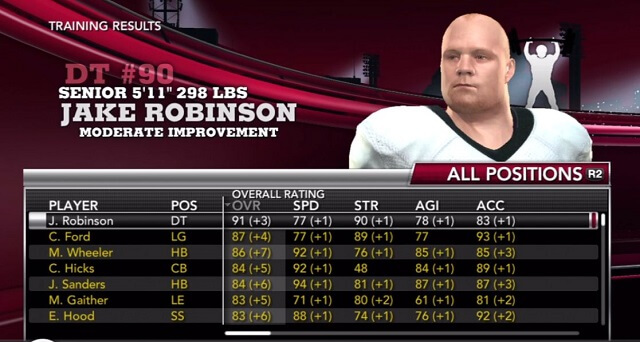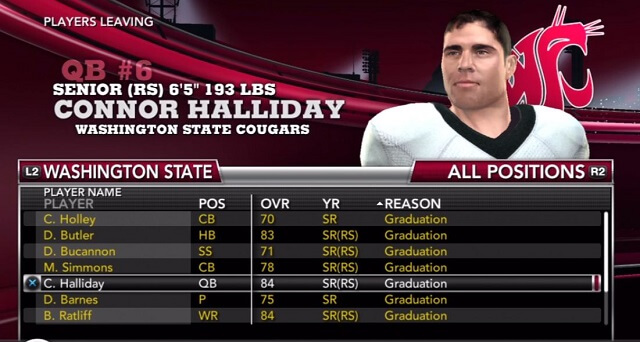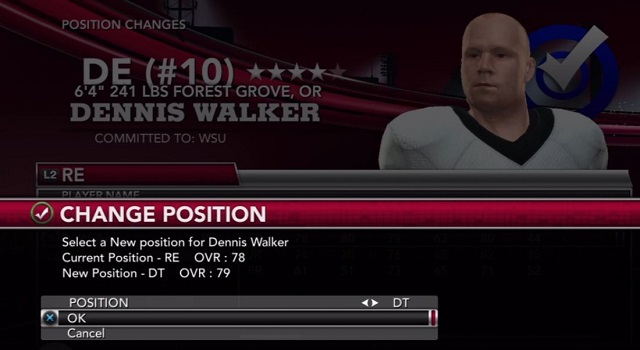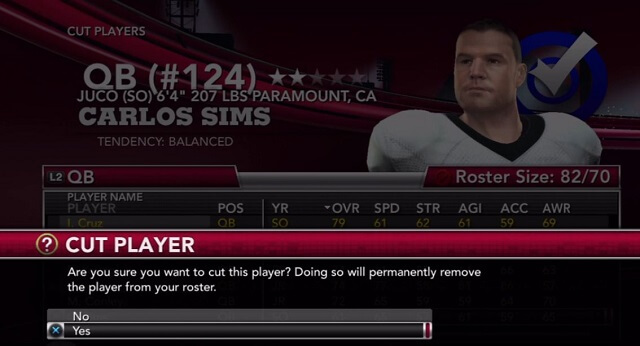Welcome to part 3, and the final chapter of Booya Gadget's NCAA 11 Dynasty Recruiting Bible Series. The focus of this article is to show some strategies, thoughts, tips and summary of the very important Off-Season of your Dynasty.

This is a critical piece of recruiting and a great place for you to try out strategies like we have here, or develop your own new customized styles based on other approaches. Your actions in the off-season can have a very positive influence on your team, the downside is that it can take a long time to complete ( real life time ). Some players may skip much of the off-season, but I recommend against it especially if you’re working with a less talented / growing team like a 2-3 star school. Universities of any Prestige can benefit from off-season tweaks. If you do a little analysis you can use this as a final opportunity to shape your team more to your liking, fill gaps from graduation and transfers, or recover from unlucky recruiting losses.
I always look forward to the off-season even though it can take a couple hours to finish. Here are some steps to get you thinking, or to serve as a foundation or dartboard for you. In my opinion, recruiting in general is half art, half science, so you should adapt these concepts to match your style and definitely do some experimenting which is a great way to learn the system.
1. Players Leaving
Every years players will leave your program for several reasons, the most common, of course, is simply graduating from college. For these guys, I tend to just glance once more at their career stats, remember the good times, and wish them well. However, when you start producing some stud players they’ll want to leave early for the Pros. Certainly, we don’t want our best players to leave the program. In this video game, I care more about my program than these playmaker’s goals. As far as I can tell statistically, there is no negative impact to convincing a player to stay, there is only upside although it may give you a drop on “early playing time” pitch. I give these players a full 60 minutes of my recruiting time until they decide. That’s the key to remember, convincing guys to stay does cost against your recruiting hours each time you try to convince him. I think it’s absolutely worth it in most cases to keep the best around as long as you can. Another reason this is a good idea is because with bad luck, injuries can come into play. I’ve lost 2 QBs in a single game, risking depth is a big risk.

2. Transfers Inbound/Outbound
In addition to graduation and the Pros you may see some of your current squad looking to transfer. Most commonly, this is from broken promises. How would you feel as a recruit if coached promised you no redshirt as a freshman, and then you got a redshirt as a freshman? Players leaving due to Transfer ( broken promises ) is another reason I mention in the Bible Part 2, that I don’t like to break promises. It results in negative coaching integrity, and players will in fact leave your program via transfer.
On the flip side, from time to time, you may get an incoming transfer request. This becomes a decision for you based on your current situation and the transfer’s skills. In general, I’ll accept a transfer unless they’re garbage, but I’ve actually seen mostly legitimate players come up by way of transfer. I don’t see incoming transfer requests very often anymore, not sure if that’s my style or just the game’s behavior. I haven’t figured out if a desire to transfer is based on a stat or characteristic. Remember, transfers have to sit out a year so don’t expect an instant fix in the year one, but they can come clutch. You can always cut him, or change his position as described in the next few points.

3. Adding Recruits for Off-Season Recruiting
At the end of your season, just prior to off-season recruiting, EA will mention that “New Prospects are available, do you want to view the Prospects?” Your answer is a YES! You don’t have to view them right then and there, but re-check the board as there is always a handful of serious talent waiting for you in this late added pool. At this point in recruiting, however, much depends on your current recruiting status ( and overall school rating ). If you have struggled in recruiting this season, or even if you have a solid class, it is worth cruising the new meat. Many times, I have landed a serious 4-5 star playmaker in this late recruiting Mini-Game ( The 5 Week off-season ). This is also one of several ways that you can potentially fix depth issues on your roster that you were unable to address during your regular season recruiting efforts. So, as referenced in the Bible Part 1, make sure to use some of the new pool to address any shortcomings by position. Outside of that you can have some fun and go for the best players available that want to come to your school. Maybe go for that top 10 scrambling QB you’ve been wanting to try.
4. Off-Season Recruiting (5) Weeks
The off-season recruiting mode is a 5 week recruiting blitz that is used to seal the deal with the last of your regular-season holdovers in addition to any new guys you added from the new player pool. For existing recruits, I hit ‘em hard, 60 minutes, get in their house and seal the deal as fast as possible. If you haven’t had the opportunity to make a scholarship offer, this is the time. In real life, you better bet a coach will ask a player to hard commit during a home visit. Sometimes it drags out a few weeks, my call aggressiveness varies slightly based on the lead ( or lack thereof ) on the competition. If a player is in his top 3, then I’d say it’s quite risky to schedule him for week 5 as he’ll probably sign earlier than that. For the players that you just added, you need to unlock those 3 favorable categories ASAP, this is why i’ll go 60 minutes, hope to unlock 3 and schedule for week 1, sometimes I’ll move it out to week 2 if necessary. So, aggressiveness to get the in house visit, is my general strategy here. The assumption is that you have hopefully wrapped up at least half your class. I always sign a few players during these weeks. The setup I use is to get at least 10 guys on your board who are ready to sign from the regular season, or the new guys that have Your University as their top choice, local, green dot type kids. Everybody gets 60 minutes, if I sign one add another, but keep it around 10. The cherry on top is if you can land a few of the recruits from the “new batch” which surfaced at the end of the season. Now is also the time to consider the non-green dots with no shame. If you have the luxury of time, use it bottom line is in this mode I think everyone should get 60 minutes, 10-12 guys max and Hammer them.
I have an additional theory that a victory in a Bowl Game greatly helps during this final recruiting period. The past 2 seasons, I have crapped-the-bed and lost 2 consecutive Bowls including the Orange Bowl… Subsequently, I also had less success during the off-season recruiting period after these Bowl losses. I am convinced that a final big win is a big boost to recruiting in the off-season. So if you lose the final Bowl Game, or don’t make the post-season, you may have more difficulty as happened to me recently.

5. My Favorite: Position Changes
I spend much of my recruiting time analyzing and performing position changes. I use position changes as a final touch to improve weak positions, fix low depth, and sometimes use it to revive an obsolete upper classman’s career. It is a win-win-win most often and is worthy of your time and consideration. In fact, depending on how deep you go with recruiting, positions changes should actually have some impact on your position recruiting strategy! The key to position changes is to understand that certain positions are linked ( interchangeable ) with similar skill requirements. For example, Defense Ends can be swapped into excellent Defensive Tackles. In fact some get a skill boost to make that swap. In my experience, I have better success recruiting the plentiful DE’s, and I have a harder time getting a lot of DT’s. So, when you’re filling the board you should absolutely consider “related-position” recruits. Tight Ends can make great fullbacks, and of course there are the obvious “in-position” swaps like ROLB to LOLB. Athletes, of course, can also give you a lot of flexibility if you managed to sign a few of them as well. I’ve found that in some situations, my signed Athletes can play over 7 different positions effectively. Not all can do that, and there are some penalties/bonuses applied but that is the upside of a top rated, fast and strong Athlete.
So, here is the real magic of Positions changes, the Booya position change mapping chart of some of the key positions. As stated above, you can use this to reference after the recruiting season, or to help when adding new recruits in “related skills” positions.
This is based off a few sample recruits, so results will vary but these are a few positions you should check. What this shows you is that if you’re having troubles landing a DT, you could overload on a position like Linebacker and Defensive End and use position changes to fill your needs. These are some of the changes I will consider. The penalties for changing position draw away from your skill rating and typically range from 1-5 points. For some players, they actualy gain a bonus for switching positions which can also be about 1-4 points. If you get a bonus, or even take a few points loss in skill points sometimes it can really help out your team.
- LB - Bonus: DE, DT
- T - Bonus: Center, Penalty: guard
- DE - penalty: MLB,OLB, DT
- DT - penalty: DE
- CB - penalty: FS, SS
- FS - penalty: CB,OLB,MLB,DE,DT,SS
- HB - Penalty: WR, FB
- FB - Penalty: TE,OL
Here is a sample showing you the positions a random freshman recruit athlete can play. ( not all athletes can play this many positions )
KYLE WEST Featured Signee. Original Position: Athlete
- 4 Star #5 Athlete 6’2” 173 Pipeline States: Yes
- POSITIONS
- WR: 69
- LE/RE: 78
- DT: 76
- OLB: 78
- MLB: 77
- CB: 72
- FS: 76
- SS: 76

6. Training Results ( Player Growth )
Obtaining high training results is another Mecca of NCAA 11 Recruiting. If you’re a stat-rat coach then training will have a result on your depth chart as well. There is no doubt that teams with higher prestige/ratings get better results. This is also proved, because there is a purchase ready accelerator to “help you train like the 6 star teams”. Also, notice that if you start with a bad team, your facilities grow as your team grows. But what I’ve found in my observation and analysis is that there are actually many factors to training results. Unfortunately, much of my findings are more theory than scientifically quantifiable, but decide for yourself if you see the same results. There is no direct action we can take during the unveiling of the training results, but EA does allow you to sort by statistics and that’s what I do to get a feel of who grew where and why.
Here are some factors I believe improve training results. My approach was to do a lot of sorting when viewing training results. The best guys have the most growth and they have the most growth because they played. Team Captains appeared to also get a training bonus along with top individual performers.
- Individual Awards: get a boost ( All American, Heisman, School Records, All Conference, Impact Players etc )
- Team Captains : get a boost
- Team Star Rating : better schools, better facilities, recruiting boost, better training.. More Stars, More Muscle.
- Playing Time: Yes, I believe playing time counts, The stats say “yes”.
- Undecided / Unknown?
- Does an award winner improve the training and or the recruiting of his peers at his position. ( Quarterback U )
- Example) Does the RB coming off a reddshirt benefit from having an All American Running back on the team despite not playing?

7. Cut Players. Who, Why ?
In general, if you have to cut ‘em then do it. Early on, cutting is easier because there will be some serious garbage floating on your rosters. The amount of required cuts can really vary from year to year with different class and recruiting sizes. I will never fear signing too many players, there are always players to cut. Sometimes there can be some tough decisions, but you softened the blow by doing a few position changes, and you can also use redshirts to help balance. There are several schools of thought, but most often I am looking for a youth movement. It is a slower growth method, but if you’re into the Dynasty for the long haul ( 6+ years at least ) you will end up with a nice cycle of continuous improvement. Cutting players comes after position changes, so you can actually reduce the amount of tough cuts by spending some thoughtful time in position changes. I just try to keep players with the best potential, at least for a while. Who would you cut: A 75 rated Redshirt Senior or a 71 True Sophomore ? In this case, the answer depends on your needs and strategy for present vs the future.
8. Use Redshirt Math to Decide
The best way to manage redshirts is to simply analyze your situation and from position to position choose short vs long term goals. Also consider that you can redshirt any player, regardless of year as long as they have not done so previously. There are too many factors to tell you the “best” way to choose redshirts, but what I can tell you is to simply consider the Math of it first. If you do not redshirt, you will get only 3 years of off-season training growth. By using a redshirt, you get 4 years of growth because you don’t grow on your way in as a freshman. Your 4th year of growth is your redshirt senior year. Example) Assuming “moderate” growth of +5/year a 70 rated freshman can “potentially” reach an 85 with no redshirt, whereas making him sitout increases his potential to approximately 90. If you redshirt as a freshman, you can potentially get a better player for longer. There’s the math, so can you wait for the guy to reach his potential or do you need him to help now ? The question becomes how is growth decided but there is no doubt that your guy will have 1 more year to grow. If you believe as I do that playing time affects growth, then the idea setup is a redshirt freshman that plays a lot for four years and wins a couple awards. This player gets the 4 years of growth from redshirting, and max potential growth from playing time. Redshirting will change as your team’s strength improves, I suppose it’s a good sign as your team may get so good that you have to sit out a year to be able to play as an upper classman. Just be prepared to alter your redshirting strategy as your team morphs.
9. Look Deeper into the Depth Chart
Deciding on a depth chart seems simple, but it is actually another place for you to deploy some of your strategies. Step 1 for me is to use the built in Auto-Depth Chart. Bam, that gives me a nice foundation to work with and auto-manages all the changes since our team has greatly changed since last year. However, after letting the cpu do a little work for you, now is the time to make some tweaks to your roster. Reconsider Tip #4 Training Results. I believe that playing time helps build growth, but if you auto manage, you will get many “out of position” players, like a Center as the backup Right Guard. Statistically the auto-manager / coach is making the right call, the 2nd best player is out there, but are you willing to let your star-to-be-Freshman rot on the bench and potentially lose off-season growth? There is a cost to playing a young guy which is that he just isn’t as good as an upperclassman peer. But, if you are convinced like me that playing time is a positive factor in off-season growth then you should manually rearrange at least a few key positions.
10. Customize your Schedules and your Future
Unlike real life, you do get to decide your schedule immediately preceding the beginning of the season. Again, there are no wrong answers here just different applications depending on your status. Starting out as a weak team, I highly recommend scheduling a few cupcakes because you need wins, you need a Bowl ! Strategy is different if you’re UT,OSU, and LSU right? The more powerful your team, the more difficult of schedule you’ll need to compete in the BCS Standings. Even with a softer schedule, you can likely still make a major bowl, but if it comes down to 4 undefeated teams and you have a C rating, you may be left out of the BCS Title game and I think that is a big risk and it can happen. If you think you’re a year away from an optimal title run, then you could soften up the schedule. Another thought if you’re feeling to up the game is to schedule a huge game at home early like week 3,4 or 5. Get as many recruits as possible to that game and win. But if you lose, that’s a lot of eggs in a basket. These are the things to consider and a few of the impacts when deciding your custom schedules. You literally have the power to take your team out of #1 contention simply by your choices here. But if you get too aggressive early, your record ( and likely recruiting ) will take a knock.
Related BooyaGadget.com Links:
- Recruiting Bible Part 1: Filling the Recruiting Board
- Recruiting Bible Part 2: In Season Calls
- Best NCAA 11 Forum with Best Players: Operation Sports
- All Booya NCAA Articles
- All Booya NCAA Videos
